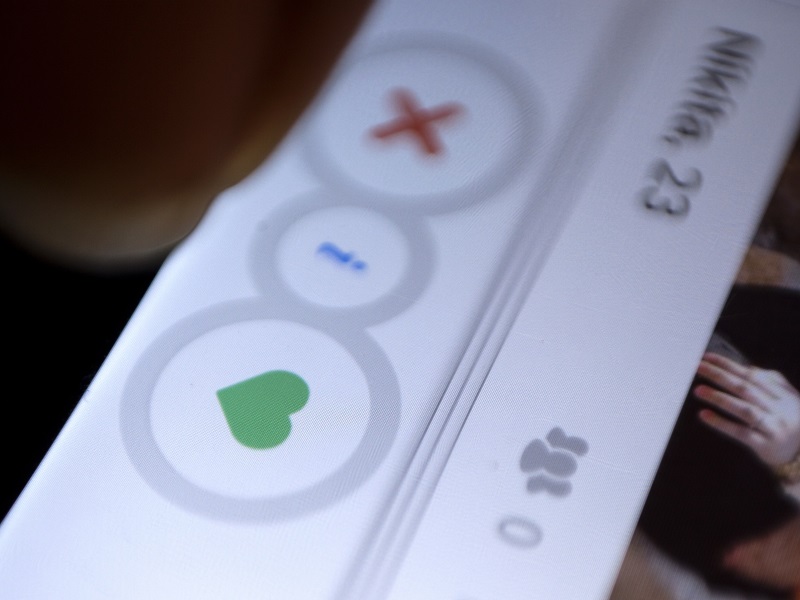
Online dating services are now hip with young adults, but not always for dating.
Credit mobile dating apps such as Tinder, which incorporate fun elements and are dead simple to use. Swipe right on a profile picture to approve and swipe left to reject. No awkward messages to each other unless both say yes.
But instead of just looking for long-term love, some people are turning to these services for one-night stands and even advice from locals when traveling. Others just want to look at sexy – and not-so-sexy – pics when they’re bored.
“It’s turned into a game,” said Tim Smith, a 21-year-old student from Hampstead, Maryland.
When he’s bored, he turns to Tinder to start swiping on women in the app, even when he doesn’t feel like talking to anyone.
(Also see: This Is How You Look While Swiping Through Tinder)
Young adults, ages 18 to 24, traditionally haven’t been big online daters. They haven’t had much of a need, as they are typically surrounded by other young, single people, whether at work or school, said Aaron Smith, associate research director with the Pew Research Center. Tinder and rivals such as Hinge are changing the dynamics, and young adults are using online dating in greater numbers than any other age group these days.
In 2013, only 10 percent in that age group used online dating. That rose to 27 percent in the latest Pew study, which was released Thursday. By comparison, only 15 percent of US adults overall have used dating sites or apps, just a slight increase from 11 percent in 2013. (If that seems low, it’s because the entire US population is surveyed, including people who are already coupled. For people who have never been married, 30 percent have used online dating.)
Stanford University professor Michael Rosenfeld wrote in a 2012 paper that the Internet could be helpful for people in “thin” dating markets, ones with relatively fewer options for possible partners in their regular life. That includes gays, lesbians and middle-aged straight people, he said.
“Conversely, single people (college students, for example) who are fortunate enough to inhabit an environment full of eligible potential partners may not need to actively search for partners at all,” he wrote.
But newer dating apps seem to have made it fun for young people to use – or at least pass the time.
Alfred Mohi, 24, said he has used Tinder for flings with people he doesn’t want to see again, and for the emotional high of matching and talking with women he deems attractive.
“I don’t know how to say this without sounding like a scumbag, but I used it as a confidence boost,” he said.
But he said he wouldn’t use Tinder to find a significant other, because he believes it’s harder to trust people you meet on the app.
Others describe Tinder as convenient and fun, and possibly a route to a relationship – but there are obstacles. “A lot of guys will message just terrible things, right off the bat,” said Maddie Forshee, a 21-year-old-student in Grand Rapids, Michigan. She said she’s been sent naked photos – “It’s like, I don’t want to see that.”
Tinder owner Match Group says half of Tinder users are ages 18 to 24, while 85 percent are 18 to 34.
Tinder seems built to sneak young people into online dating. “I wouldn’t even call it dating – I don’t think you need to call it dating,” said Amarnath Thombre, Match Group’s Chief Strategy Officer. “You enter like you’re trying to play a game and then you end up dating people. It’s more like a psychological switch.”
Pew’s survey shows that some older adults are also more interested in online dating. Usage among 55 to 64 doubled to 12 percent. Pew’s Smith said they probably feel more comfortable with the idea of finding a partner on the Internet as they hear about successful matches from friends and relatives.
Of course, there are exceptions: Edward Stern, a 62-year-old New Yorker, said he has been an online dater for decades and finds more cynicism today.
“I could tell you what it was like in the ’90s. People weren’t as afraid or distrustful,” he said. “That’s my biggest impression of what’s going on today. You have to pull teeth to get people to meet you.”
He said he typically ends up going out with women in their 20s, because those are the ones who respond to him. He says he’s happy with “fun” rather than a long-term relationship.
Pew conducted the survey June 10 to July 12, 2015, with 2,001 US adults. Interviews were conducted in English and Spanish. The survey has a margin of sampling error of plus or minus 2.5 percentage points.
Download the Gadgets 360 app for Android and iOS to stay up to date with the latest tech news, product reviews, and exclusive deals on the popular mobiles.




